China struts its military might and announces troop cuts
- Share via
China marked the 70th anniversary of the end of World War II in Asia with a massive parade featuring tanks, aircraft and thousands of goose-stepping soldiers.
Chinese leaders said the spectacle was intended to remember the country's contributions to the war and uphold peace. President Xi Jinping announced a 300,000 troop cut.
But the extravagant weaponry display added to deep concerns in the United States — as well as in Japan, Vietnam, the Philippines and elsewhere — about China’s military capabilities and intentions.
Los Angeles Times reporters provided updates from China and the region.
Find more photos and full coverage .
The end
How does China's military stack up?
China's military remains well behind the U.S. in many areas and beset by problems, including corruption, that raise doubts about its ability to conduct a full-scale conventional conflict, Pentagon officials and analysts say.
Its 1.2 million soldiers have little or no combat experience and often carry outdated equipment.
With 2,100 combat aircraft, China has the largest air force in Asia but still lacks in-air refueling capability that would enable it to fight over long distances.
Its navy has over 300 ships and submarines, but they are primarily focused on operating close to shore, not in the open ocean.
At the same time, Beijing seems intent on fixing many of those problems, no matter how long it takes.
In the South China Sea, for example, it has spent the last two years building large artificial islands on once-tiny reefs and rock outcrops. U.S. military officials worry that China is trying to establish de facto control over parts of a strategic international waterway
Adm. Harry Harris, who took over in May as the top U.S commander in the Pacific, warned last month that China has started building runways and other military facilities on the man-made islands.
“Any increase of capability like that in that area is cause for concern,” Harris said.
He's baaack
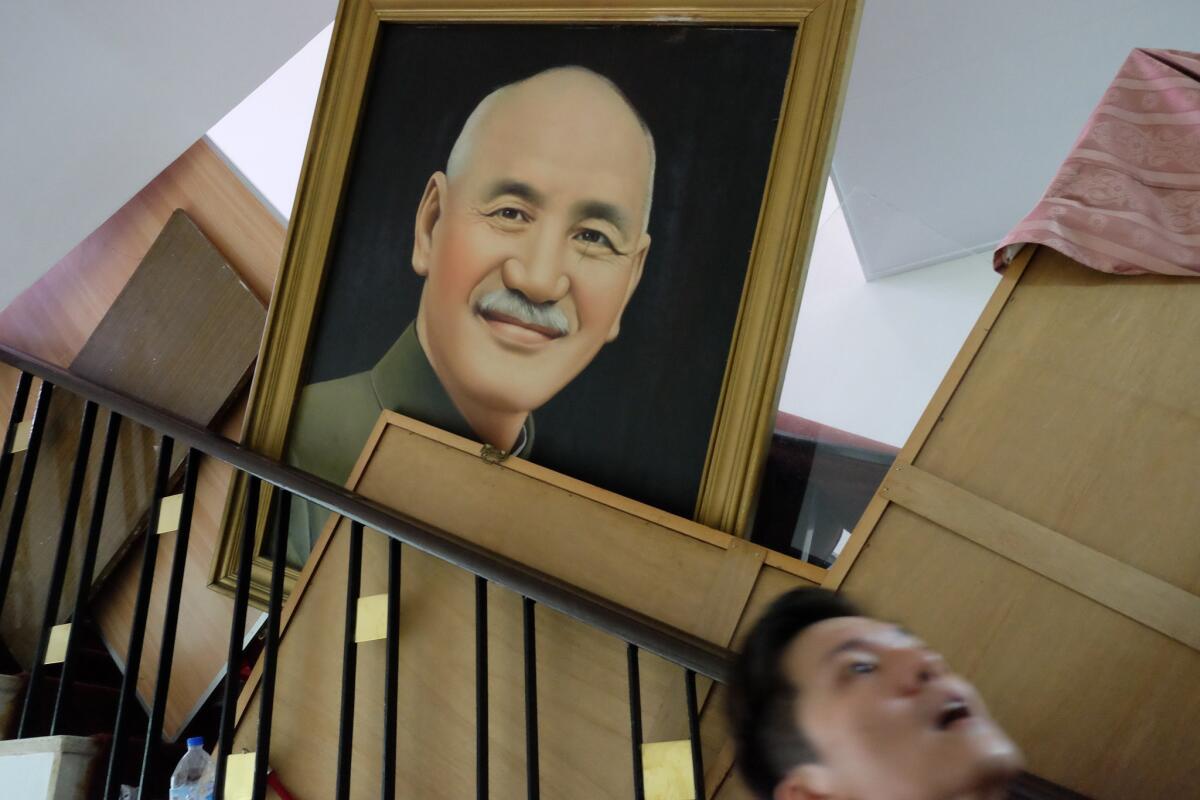
A portrait of the late Taiwan president Chiang Kai-shek hangs inside parliament in Taipei.
Well look who's back! It's Chiang Kai-shek, who led China's Nationalist government campaign against Japan 70 years ago.
On Thursday morning, Taiwanese media broadcast a recorded speech he gave in August 1945.
“Fellow soldiers and people around the world who love peace, our war of resistance is victorious today,” Chiang said in loud, passionate Mandarin with the accent of his home province south of Shanghai. “The truism that justice must prevail over power finally reached its final proof.”
Chiang's Nationalist Party now governs a vibrant Taiwan -- it lost China to the Communists in a civil war after Japan surrendered -- and normally doesn't talk about the strongman who died in 1975.
Some Taiwanese still remember and resent losses, restrictions or threats against them during his authoritarian rule.
But officials including Taiwan's president are using the anniversary to remind people that the Nationalists, not the Communists as claimed by Beijing, beat Japan in World War II. The strongman's speech, they hope, offers final proof.
Xi's speech
The official New China News Agency has published an English-language translation of President Xi Jinping's speech. Here's an excerpt:
Putin celebrates Russia's ties with China
Russian President Vladimir Putin joined China's lavish World War II commemoration and said his country's newly intensified relations with Beijing had “reached a peak in their entire history.”
“Our two countries were allies in the fight against Nazism and Japanese militarism and bore the brunt of the aggression, and they not only withstood this battle but won it, liberating enslaved peoples and bringing peace to the planet,” Putin said in an interview with the official Tass and New China news agencies before he left Moscow.
Putin stopped en route Wednesday in the Siberian city of Chita, near the Chinese and Mongolian borders, to attend a victory anniversary parade, lay a wreath at a war memorial and meet with local veterans. The side trip was a rare Kremlin commemoration of the Asian role in defeating the Axis powers.
Putin's two-day visit to Beijing to attend Thursday's massive military parade and meet with top Communist Party officials on economic projects returns the honor bestowed on Russia's May 9 celebrations of the war victory by Chinese President Xi Jinping's presence. Xi was the guest of honor at the Red Square event that was boycotted by the Soviet Union's wartime allies over Putin's seizure of Ukraine's Crimean peninsula in March 2014.
The Western World War II allies -- the United States, Britain and France -- sent lower-level delegations to Beijing for the events marking the 70th anniversary of Japan's surrender.
Trade turnover between Russia and China reached $88 billion last year, Putin said, making Beijing the country's key economic partner at a time of “illegitimate restrictions imposed by certain Western countries against Russia.” He was alluding to the sanctions imposed by the European Union, the United States and other Western countries to punish Russia's role in the Ukraine crisis.
China's pivot toward South Korea

Chinese President Xi Jinping, right, stands with Russian President Vladimir Putin and South Korean President Park Geun-hye at a military parade in Beijing.
Amid the pageantry in Beijing on Thursday was the latest display of China's blossoming relations with South Korea - and growing distance from North Korea.
Presidents Park Geun-hye of South Korea and Xi Jinping of China were taking in the parade together, after holding a summit in Beijing on Wednesday, their sixth since Park took office in early 2013.
Xi and Park have a few things in common: They are just one year apart in age, and both are the children of prominent politicians.
Park speaks Mandarin, which gives them a common language. She won friends in China when she made a public address in the local language on her first official visit to Beijing in 2013.
Robust commercial ties provide the foundation for relations between Beijing and Seoul. The two countries signed a free trade agreement this year. Bilateral trade has grown under their watch, and they are united in opposing North Korea's nuclear program.
Xi's pivot toward South Korea came last summer when he made his first visit to the country, breaking with a custom among Chinese presidents to visit North Korea first.
Charles Armstrong, a Columbia University professor, argues that Park's presence in Beijing while North Korean leader Kim Jong Un remained at home “reflects a shift in China's attitudes toward the Korean peninsula, showing that the special relationship between China and North Korea has been downgraded.”
Some of the hardware on display
Role of China's army: 'safeguarding peace'
Chinese state media have attempted to refute accusations, mostly from foreign observers, that authorities planned the parade as a show of brute force to intimidate regional rivals.
“Today's army is training a generation of quality troops with tough spirit, combat capability, fortitude and fine character,” the state broadcaster CCTV said. “One of the most enduring lessons of the war for China is the need to unswervingly pursue the path of peaceful development. The army plays the role of safeguarding peace for the country and the world.”
"We cannot tolerate sand in our eyes,” the anchor said, quoting President Xi Jinping. The sand consists of “distorting history, covering up atrocities or attempting to detract from China's victory” in World War II, she continued.
Meanwhile, TV broadcasts showed Xi rolling down Changan Avenue in central Beijing, surveying lines of saluting, camouflage-clad troops.
How China is viewed in the region
Countries involved in territorial disputes with China, such as Vietnam and Japan, have a far dimmer view of the country than other Asia-Pacific nations, according to a poll by the Pew Research Center.
The organization surveyed 15,313 people across 10 countries in the region in April and May. More than half of respondents from Indonesia, South Korea and Australia expressed a favorable opinion of China, a sentiment shared by fewer than 20% of respondents in Vietnam and Japan.
In the Philippines, 91% of people expressed concern about territorial disputes with China.
“Publics in the Asia-Pacific region generally see each other favorably, with a few exceptions that reflect deeper historical antagonisms, especially between China, Japan and South Korea,” said a post on the center's website.
Not likely to be impressed: North Korea
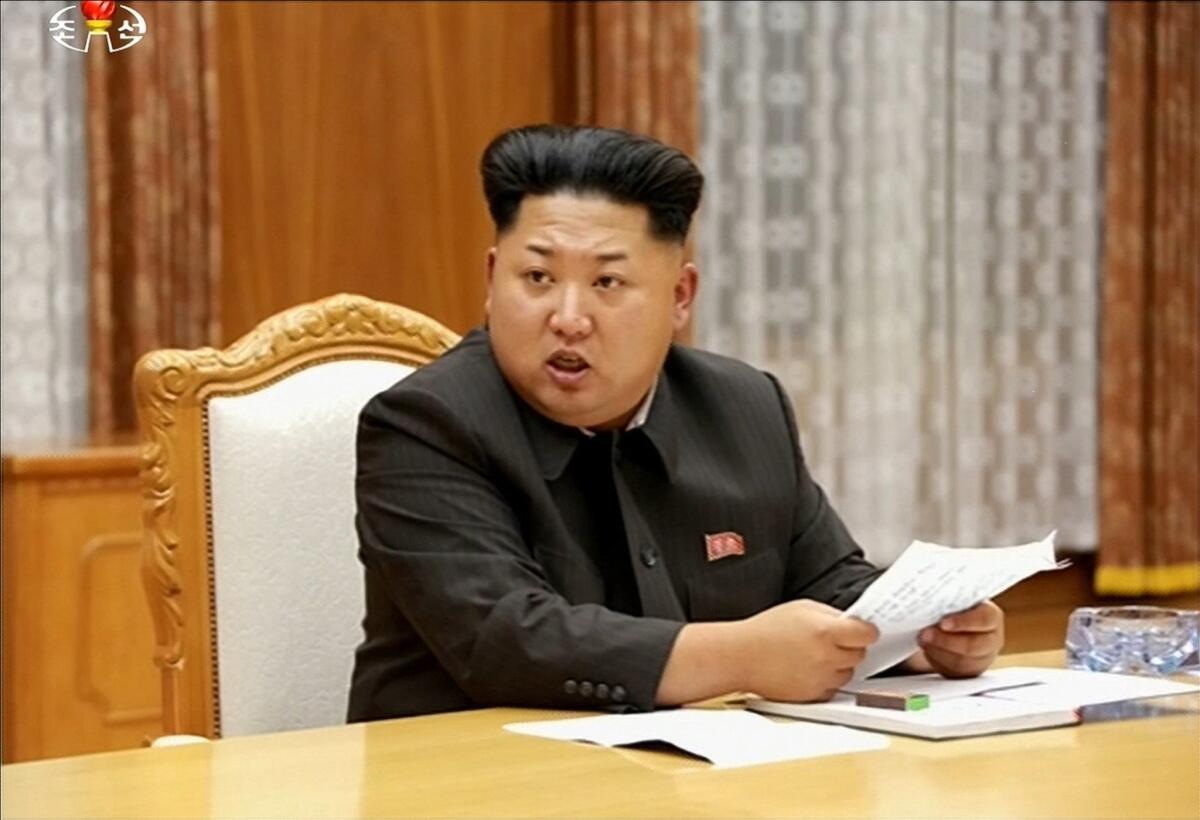
North Korean leader Kim Jong Un at an emergency meeting of the Central Military Commission on Aug. 20, 2015.
While China flaunts its military clout, there is one country in the region unlikely to be either impressed or daunted.
North Korea, Beijing's unpredictable neighbor with a penchant for showing off its own powers of disruption, remains a political and strategic loose cannon in Asia and defiant of the aid and advice of its Chinese ally.
Kim Jong Un has been in power in Pyongyang for less than four years. But during that time he has carried out prohibited nuclear weapons tests, exchanged fire with South Korean adversaries on the other side of the demilitarized zone, threatened to annihilate perceived enemies in the West and peremptorily shut down operations at the joint venture industrial parks that Chinese investors created to help them.
China is North Korea's most important trade partner, accounting for 80% of Pyongyang's foreign commerce. Last year the hermetic communist country imported $4.02 billion worth of Chinese goods and sold its neighbor $2.84 billion in products, much of it the output of the on-again, off-again special economic zones.
Beijing this week inaugurated a 129-mile high-speed rail line between the northeastern Rust Belt city of Shenyang and the border port of Dandong, intended as further inducement for Pyongyang to reform its economy and engage in more collaborative ventures with its neighbors.
China also announced recently that it was planning a border trade center in Dandong, expected to open in October during a trade, cultural and tourism exposition by the two countries.
Pentagon says China is aiming to project power
Pentagon officials warn that China's rapid military modernization is aimed at projecting power in East Asia and at raising the risks for the United States if it intervenes in maritime hot spots, such as the South China Sea or the Taiwan Strait, where Beijing has territorial claims.
For that reason, they say, Beijing has spent heavily on anti-ship cruise missiles, air defense systems, submarines and other advanced weaponry in hopes of forcing U.S. aircraft carriers and fighter jets to operate farther away from the Asian mainland if a conflict should break out.
China's anti-ship cruise missiles have ranges exceeding 1,000 miles, providing “the capability to attack aircraft cariers in the Western Pacific,” a Pentagon report on China's military said in May.
It also has worked on developing ballistic missiles capable of knocking out satellites and a cyberwarfare capability, so that if war comes, it could attempt to deny the U.S. one of its chief advantages: its use of networked sensors, surveillance satellites and data transmission to find and target adversaries.
The goal is to develop a military that can fight “short-duration, high-intensity regional conflicts,” the report said.
Is China demilitarizing?
Rory Medcalf, head of the National Security College at Australian National University, says Beijing may have decided to cut 300,000 troops for the sake of "efficiency and cost saving, so that the defense budget can be reallocated to 21st century capabilities."
"Infantry are no longer a measure of power," he says. "One metric to watch is overall military spending, which goes up in China by double digits each year - ahead of economic growth. Another metric to watch is the development of new and leading-edge technologies like cyber, hypersonic missiles and submarines."
The view from Japan
Japan's conservative media are portraying Thursday's military parade in China as a covert slap in the face.
The right-wing newspaper Sankei Shimbun published on its front page a sort of rogues gallery of international leaders attending the event.
NHK, Japan's public broadcaster, said the Chinese government was holding a military parade to commemorate "the 70th anniversary of what China calls its victory over Japan.”
Japanese Prime Minister Shinzo Abe has never quite admitted that Japan invaded China -- it makes it easier to make a case that China never defeated Japan.
Japan's home-grown version of YouTube, NikoNiko Live, is broadcasting the military parade in real time, and the comments from viewers flashing across the screen are generally disdainful:
“It doesn't look like anything but fascism to me.”
“Dangerous, dangerous.”
“Are we starting to see some smog in that blue sky?”
China's assertion of ownership of a group of islands it calls Diaoyu and which Japan calls Senkaku has stoked anti-China sentiment in Japan, and the Abe administration has been quick to exploit this as it tries to push through new security laws.
For the Abe administration, Thursday's military parade is a PR plus. It bolsters the administration's claim that China is a threat that Japan must have greater freedom to fight with a stronger military.
China to cut troops by 300,000
Chinese President Xi Jinping, in a speech marking the start of the parade, has announced that China will cut the number of its troops by 300,000. He did not explain the thinking behind the decision.
"The great renewal of the Chinese nation requires the dedicated efforts of one generation after another," he said. "Having created a splendid civilization of over 5,000 years, the Chinese civilization will usher in an even brighter future."
Taiwan held its parade in July
China's Communist-led government takes liberal credit for leading the country's long struggle against Japanese troops during World War II. But outside the mainland, scholars agree that it was the Nationalist Party-led forces of Chiang Kai-shek that did the vast majority of the fighting.
“The Communists were not doing battle with the Japanese. They were trying to get Nationalist soldiers to defect to their side,” says Tao Shin-jun, a 97-year-old veteran of the campaign.
Japanese forces in China formally surrendered to Nationalist army commander He Ying-qin in Nanjing on Sept. 9, 1945.
However, a civil war flared between Mao Tse-tung's Communist forces and Chiang's battle-weary troops. In 1949, Chiang and millions of his supporters retreated to Taiwan, an island 100 miles off the mainland's southeastern coast.
Authorities in Beijing invited surviving Nationalist soldiers and other prominent figures in Taiwan to Thursday's parade, but the overtures were met with suspicion and distrust.
Taiwanese President Ma Ying-jeou strongly discouraged any islanders from participating in the event. Taiwan held its own World War II commemorations in July, feting old soldiers like Tao.
The ceremonies begin
China's military hardware not purely defensive
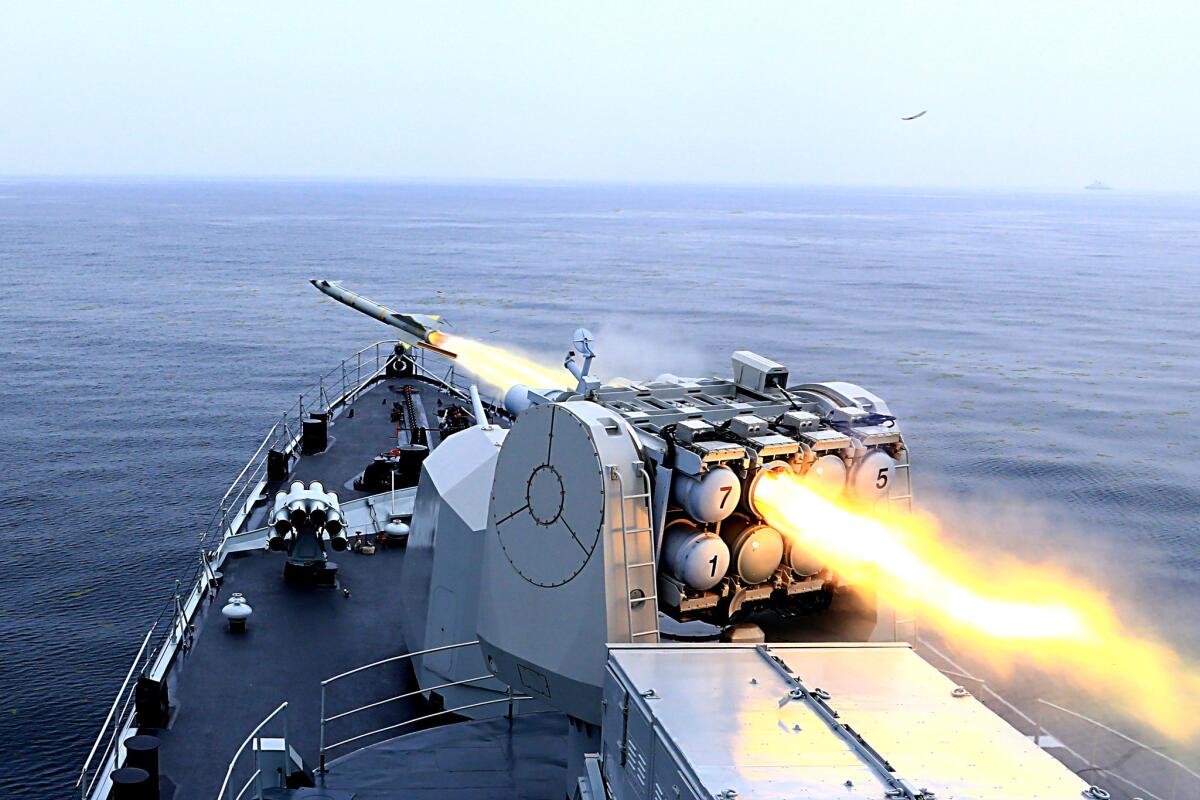
A Chinese frigate participates in a live-fire drill July 2. The country will showcase its military might in a Sept. 3 parade.
Foreign analysts say China's new generation of military hardware is by no means purely defensive.
Since the late 1990s, while the U.S. focused on wars in places such as Serbia, Iraq and Afghanistan, China has been studying how Washington fights ¿ in particular, relying on precision-guided munitions and building up forces near the theater ¿ then developing strategies and equipment that could take advantage of American weaknesses to keep U.S. troops at bay.
Chinese forces have acquired numerous inexpensive but deadly short- and medium-range ballistic missiles, as well as anti-ship cruise missiles, and have invested deeply in a submarine-building program that has been much more productive than Pentagon officials anticipated, said Scott Harold, deputy director of Rand Corp.'s Center for Asia Pacific Policy.
China, he said, is trying to “make it very lethal” for anyone to enter disputed maritime territory that it lays claim to in the East and South China Seas.
Of particular concern, say U.S. defense experts, are China’s J-20 and J-31 stealth aircraft, as well as the DF-26 intermediate range ballistic missile, which Chinese Internet users have dubbed “the Guam Express.” It could reach the increasingly large numbers of troops the U.S. is putting on the Pacific island as part of its “pivot” to Asia strategy.
China 'not trying to scare the U.S., Japan ... or anyone'
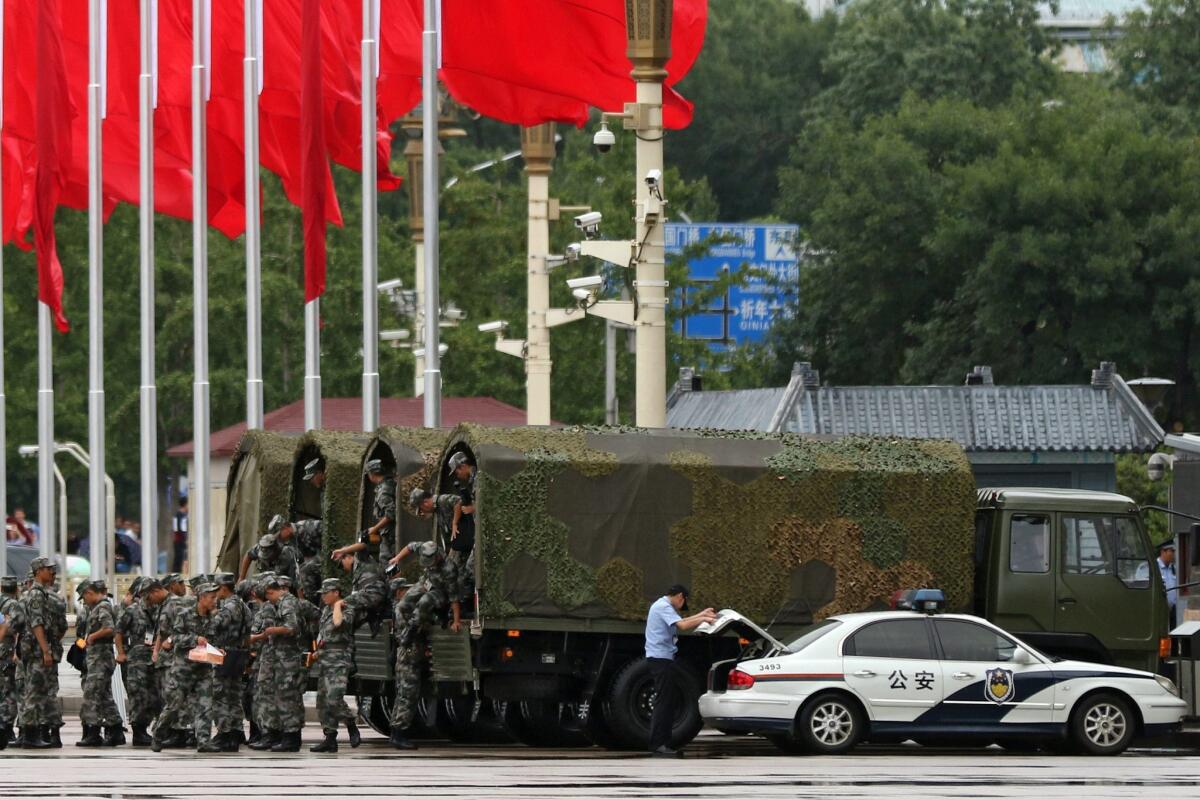
Chinese soldiers disembark from trucks Tiananmen Square in Beijing on Sept. 1 amid preparations for a major military parade.
Chinese analysts and state media reports have said that authorities are staging the parade partly because they believe that the country's contributions to World War II -- and its suffering -- have never been sufficiently recognized by the rest of the world.
China is “not showing off” and is “not trying to scare the U.S., Japan, the Philippines or anyone,” said Xu Guangyu, a retired Chinese military officer and consultant to the China Arms Control and Disarmament Assn. “There is still a big gap between China's hardware and capabilities and those of advanced countries like the U.S.”
The parade, he said, is intended to promote Chinese unity and “show that we are addressing our security needs at a reasonable level.”
He added that China is increasingly engaged in international security efforts such as anti-pirate patrols.
Why China's parade is rattling the region
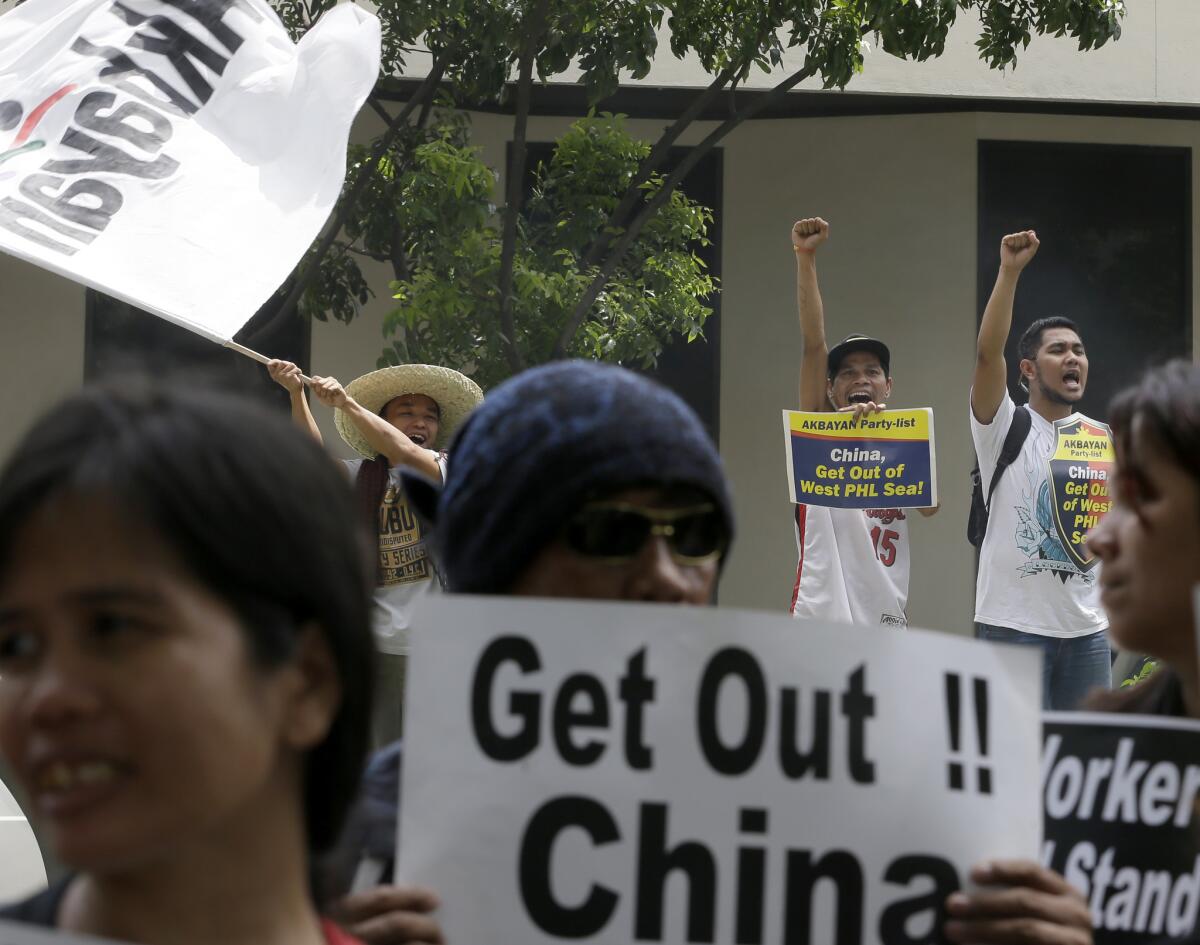
Demonstrators gather outside a Chinese consulate in the Philippines in July to protest the building of artificial islands in the South China Sea.
Under the leadership of President Xi Jinping, China has projected its growing armed forces' capabilities farther from home with increasing assertiveness, particularly at sea.
This year alone, the country has built artificial islands in the South China Sea, held a joint live-fire naval drill with Russia in the Mediterranean and sent its navy to evacuate hundreds of Chinese citizens from war-torn Yemen.
China claims most of the South China Sea as its sovereign territory, putting it in conflict with the Philippines, Malaysia, Vietnam, Taiwan and Brunei.
The country is not alone in pursuing land reclamation projects or building small military installations on contested islands. But its recent dredging has been on a far greater scale than other countries, according to U.S. officials.
Satellite images show that China has begun building piers, helipads and airstrips on the islands, which could significantly bolster its military and surveillance capabilities in the area.
Monkeys and falcons and jets, oh my!
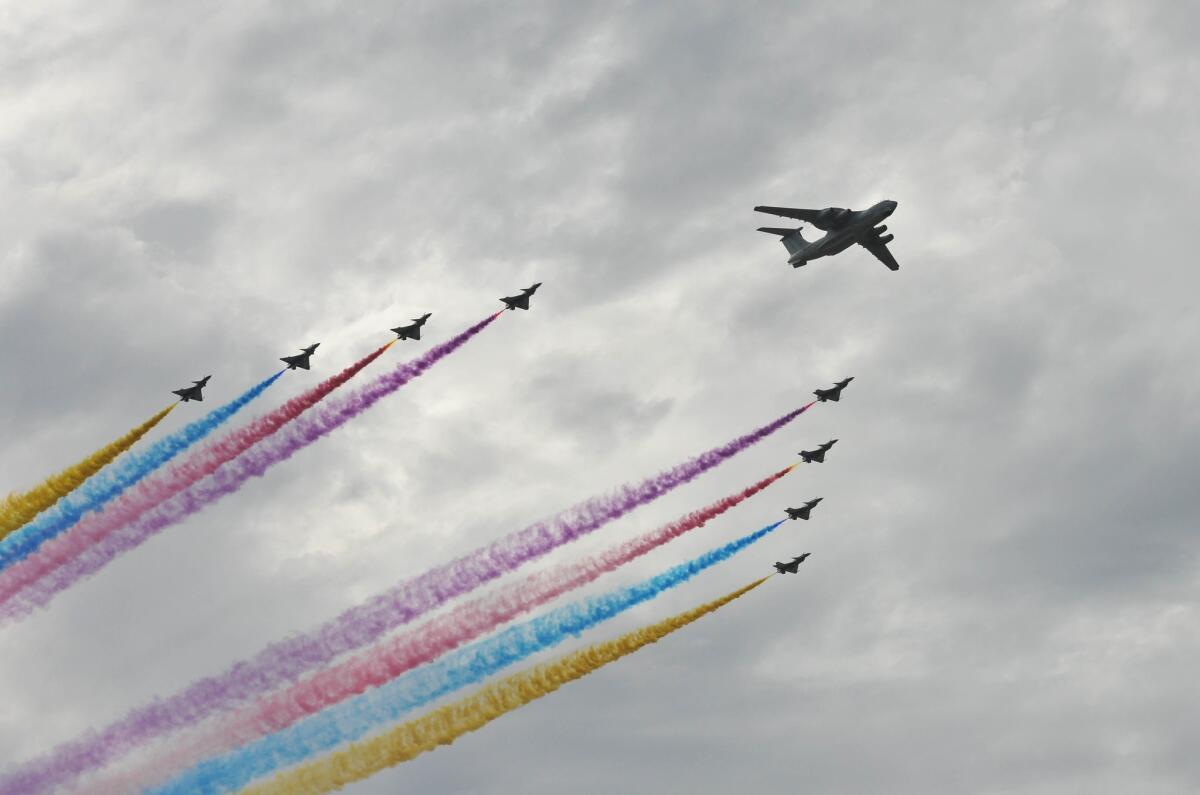
A formation of military aircraft performs Aug. 23 during a rehearsal ahead of celebrations in Beijing to mark the 70th anniversary of the end of World War II in Asia.
Authorities in the Chinese capital are pulling out all the stops to make sure that the parade goes according to plan.
The military has enlisted a squad of falcons and monkeys to help clear the skies and protect jets from the threat of flying birds, state media report. Trainers at an unspecified air force base in Beijing have been methodically dispatching macaques to scamper up trees and destroy the birds' nests, then sending falcons to frighten them away.
“Two of the macaques, named Qitian and Ziyun, can get rid of a nest in approximately one minute,” said a report on china.org.cn, a news website overseen by China's State Council Information Office. “[The trainer] needs to shout 'hurry up' at times to encourage the hesitant monkeys, who receive rewards like corn for a job well done."
Authorities are also temporarily closing several major roads, gas stations, shopping districts, concert halls, parks, bars, long-distance bus terminals, hospital outpatient departments and even the city's airports. And they are dispatching 850,000 “volunteers” to stand on the sidewalks wearing bright red armbands, on the lookout for signs of trouble.
The last big parade
China typically has staged a large military parade through Tiananmen Square on every 10th anniversary of the founding of Communist China.
The last event, in October 2009 under President Hu Jintao, showed off Chinese-made fighter jets, missiles and other hardware.
Parade swag

Some of the swag provided to attendees at China’s massive military parade on Sept. 3, 2015.
Parade attendees will get swag bags. They pale in comparison with Oscar season giveaways but here's a look at them:
1. Bag itself. Choice of color: Red, blue, green and yellow. Front logo is the great wall with doves and 1945-2015. Back logo: Dove. Leather handle. Zipper pull has nice "70" logo
2. Red ball cap
3. Temporary tattoos
4. Rain poncho
5. Flags -- one Chinese, one for parade
6. Water
7. Tissues
8. Chinese medicine.
Who's coming to the party?
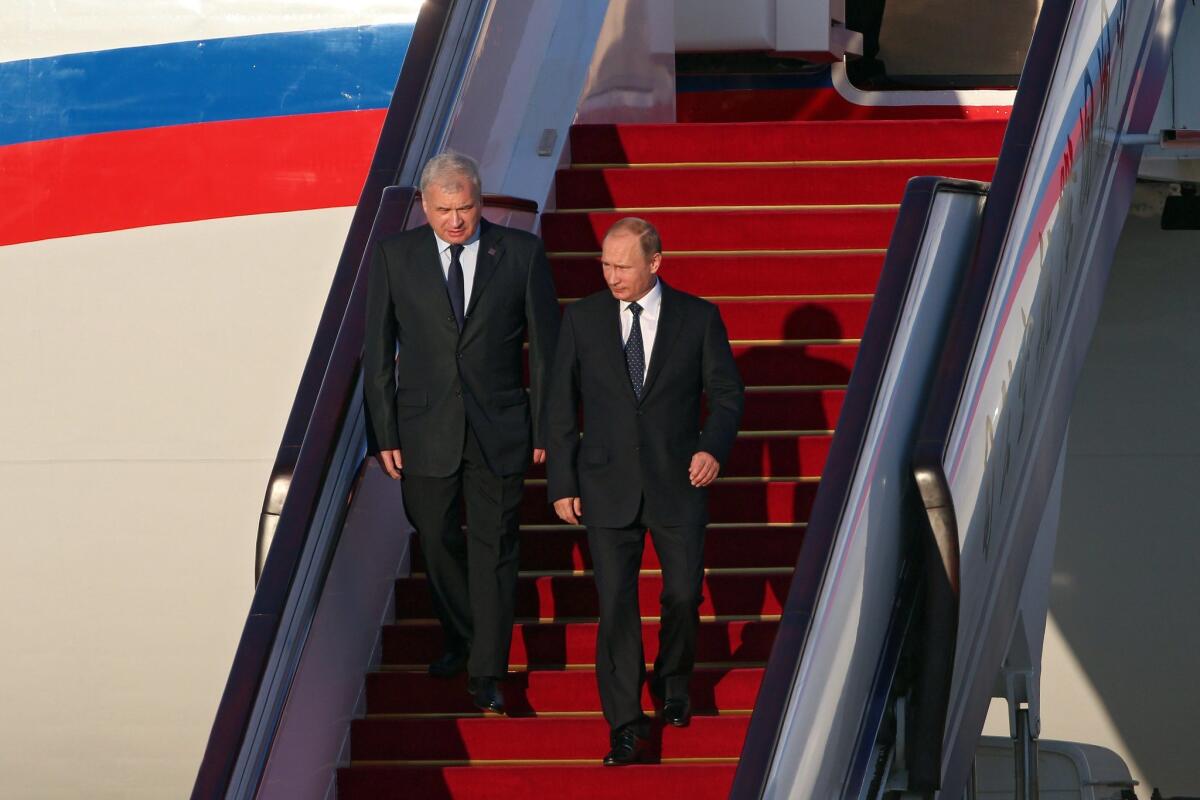
Russian President Vladimir Putin, right, arrives in Beijing on Sept. 2, 2015, to attend a military parade marking the end of World War II in Asia.
Representatives from 49 countries are scheduled to attend the parade, including an estimated 30 heads of state, 19 "high-ranking government officials," 10 heads of international organizations, and 100 “foreign war heroes,” according to China's state news service.
Among them are Russian President Vladimir Putin, South Korean President Park Geun-hye and U.N. Secretary-General Ban Ki-moon.
But many Western heads of state have declined their invitations. Several countries, including the United States and Canada, are sending their ambassadors to China.
Germany is sending its former chancellor, Gerhard Schroeder, while Britain has dispatched former Prime Minister Tony Blair. Czech Republic President Milos Zeman is the only head of state from the European Union set to attend.
Getting ready
Hundreds of buses are delivering journalists, military musicians and guests to Beijing's Tiananmen Square as China prepares to kick off its military parade Thursday morning.
Reporters had to arrive for security checks at 4:30 am. Some paid over $400 for last-minute rooms near the site for fear that traffic restrictions would make it impossible to reach the area.
The ceremonies begin at 10 am with a speech by President Xi Jinping followed by a 50-minute procession of troops and armaments.
Two huge video screens have been set up on the north side of Tiananmen Square. NFL-style cameras suspended on wires, the kind used to provide close-up tracking shots, have been strung over Chang'an Avenue to ensure state-run media outlets miss no possible angle.
Some 37,000 spectators are expected in the yellow, red, blue and green seats.
Temperatures are expected to climb into the 90s, and already at 7 a.m. a strong sun was baking the square. A caravan of water trucks and street sweepers (electric vehicles!) made a final pass in front of the gate where Mao Tse-tung's portrait hangs, as a band and all-male choir warmed up.
Watch the parade live from Beijing
The New China News Agency will provide a live stream of the parade at 10 a.m. local time / 7 p.m. PST.
Sign up for Essential California
The most important California stories and recommendations in your inbox every morning.
You may occasionally receive promotional content from the Los Angeles Times.







